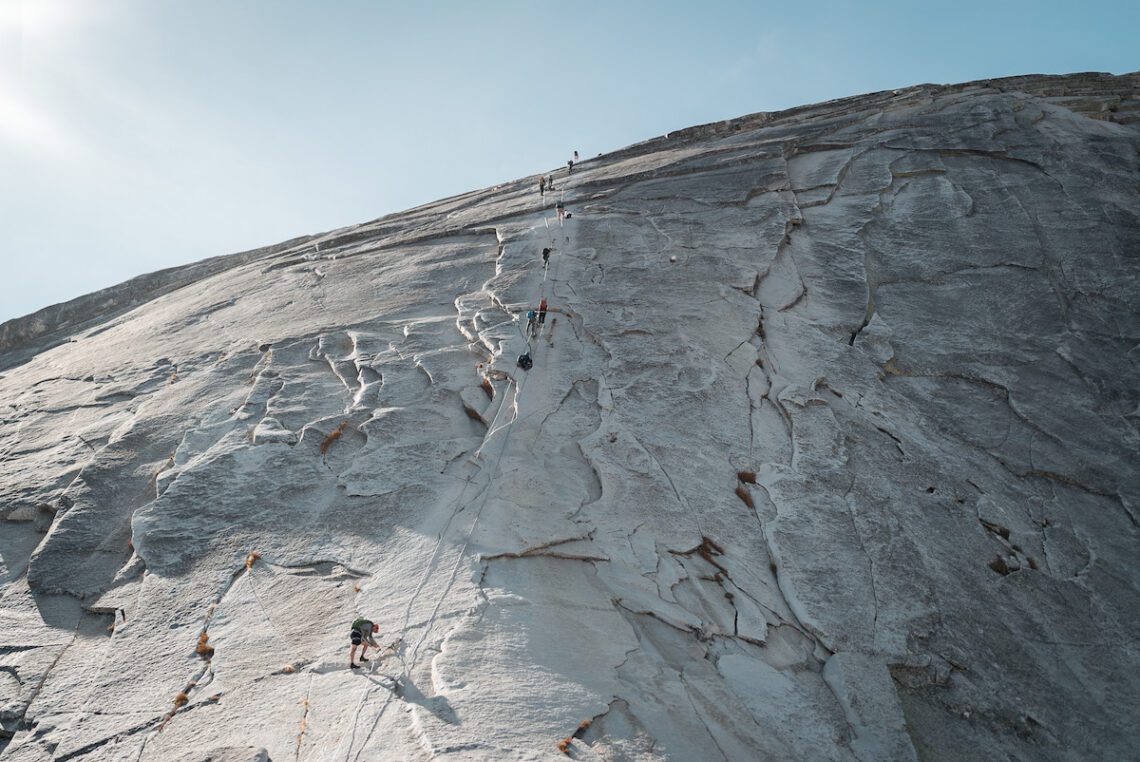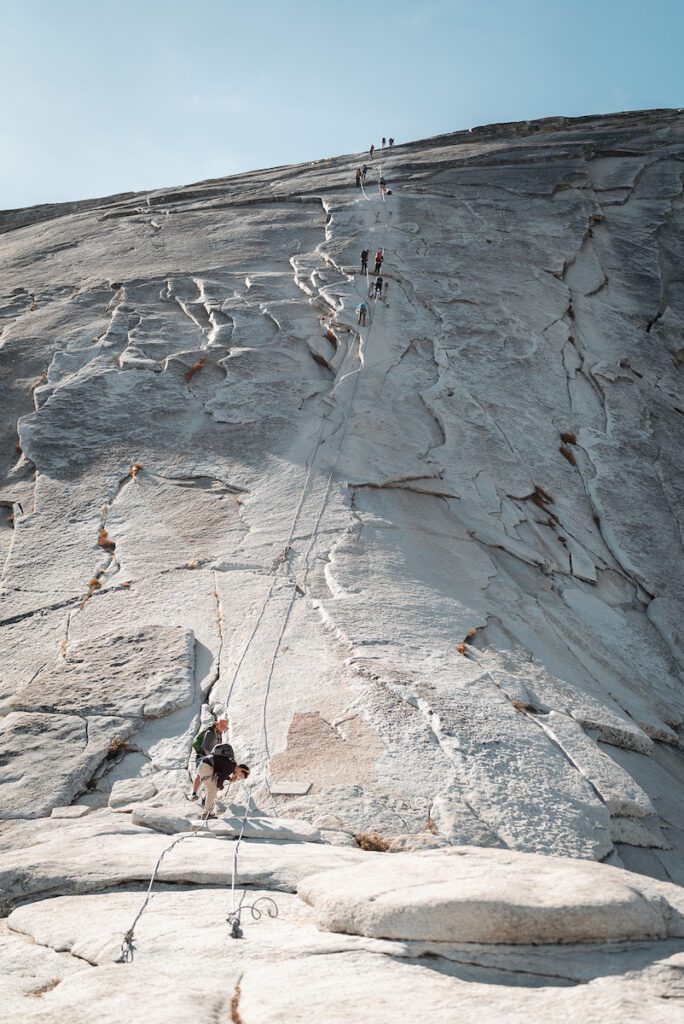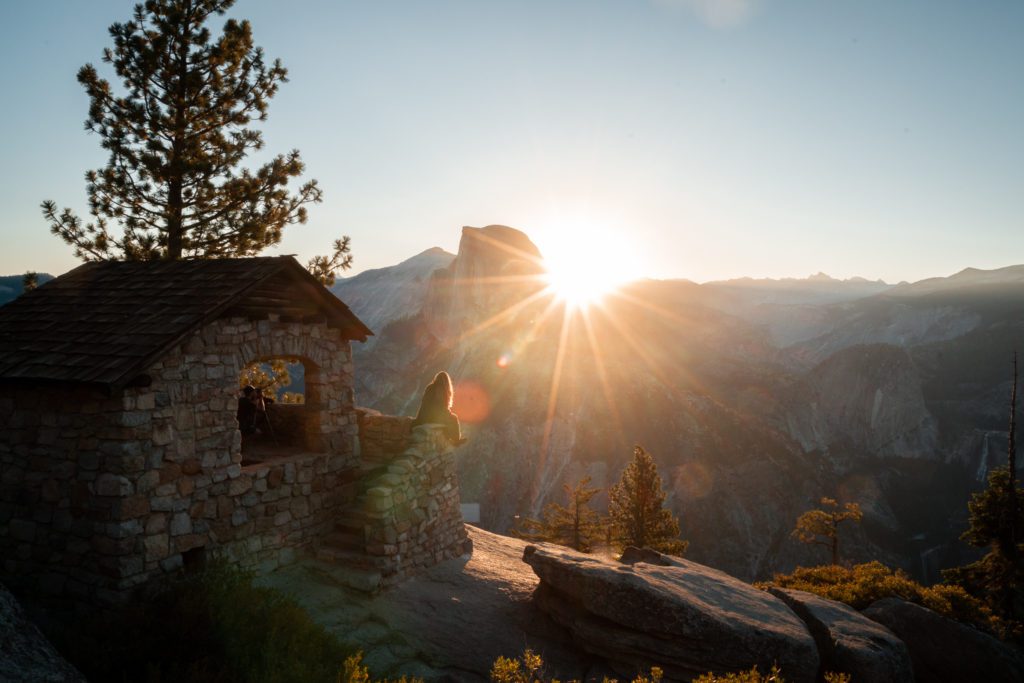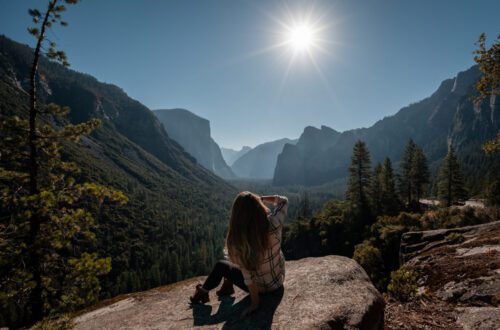
How to Hike Half Dome Cables Down
Cassie’s Compass contains affiliate links and is also an Amazon Services LLC Associates Program member. If you make a purchase using one of these links, I may receive compensation at no extra cost to you. See my Privacy Policy for more information.
Hiking Half Dome in Yosemite National Park is a bucket list experience for many hikers. The 18-mile round-trip journey leads you up 4,737 feet from the valley floor to the iconic granite peak.
The hike gets its infamy from the last 400-foot ascent up smooth exposed granite at a 45-degree incline using just two steel cables.
And when those cables are down the hike is even more of a challenge. But, hiking Half Dome cables down is possible.
In the summer, the “cables are up,” meaning the cables are propped up like handrails with wooden slats installed along the face of the granite as footholds.
When the “cables are down” the wooden slats are gone, and the two cables lay flat against the granite. The cables are still anchored at both the top and the bottom of the dome. But instead of using the cables as handrails, you use a single cable to pull yourself up hand-over-hand.
Here is everything you need to know about hiking Half Dome cables down.
Half Dome Cables Down Dates 2022-2023
The Half Dome cables are usually up Memorial Day through Columbus Day. (The last Monday in May through the second Monday in October.)
The cables came down on October 10th, 2022, and went back up in June 2023. All dates are subject to weather and other conditions.



When the cables are up, a permit is required and up to 300 hikers summit Half Dome per day. The lottery for a Half Dome permit is open throughout the month of March and winners are announced in April.
You do not need a permit to hike Half Dome when the cables are down. I would estimate that less than 100 hikers summit Half Dome per day when the cables are down, considerably fewer still the colder and later in the season you get.
How to Tie Into Half Dome Cables with a Prusik Knot
When the cables are down, you will use a single cable to pull yourself up hand-over-hand. Since the added safety of raised cables and foot planks is gone, you will need a rock climbing system to attach yourself to the cable.
Tying into the cables with a prusik knot is the most common technique. A prusik is a friction hitch that can be used to attach a rope to an object, and it’s perfect for attaching yourself to the cables. To tie a prusik knot, you’ll need two carabiners, a harness, and two loops of climbing cord.
Wrap one looped rope around the cable three times. Then, pass the knotted end of the rope through the loop and attach it to the carabiner and your harness. The second loop and carabiner will be used as a safety backup and for alternating the ropes at each cable junction.
Study how to tie a prusik knot and practice using your climbing system before you begin your hike. This is an advanced hike and can be dangerous when hikers are unprepared.
Gear for Climbing Half Dome
Of course, before you attempt to scale the cables when they are down, it’s important to have the proper gear. Here are some essential items to bring:
- Gloves: The best gloves for Half Dome have an adjustable wrist strap and fit snuggly.
- Climbing Harness: Try on your harness before you start your hike!
- Locking Carabiners: You will need three locking carabiners for the prusik system. It’s always a good idea to bring an extra if you have one.
- Friction Hitch Loops: You will need two rope loops for the prusik system.
- Day Pack: Have enough space for layers, water, food, and the climbing system
- Trekking Poles: I desperately wish I had these to help with the descent. Must be collapsible and must be lightweight.
- Headlamp: Bring for starting early or finishing late, especially when the cables are down and the days are shorter.
- Hiking Boots: Break in your boots. Make sure they have good traction, ankle support, and are lightweight. Forsake is my brand of choice.
- Spare Socks: This was a lifesaver on the descent.
- Water Bottle Purifier: Four liters is the minimum recommended for this hike. Save weight and refill your bottles with a purifier.
Cables Down Difficulty
When the cables are up, Half Dome is considered one of the most challenging day hikes by the National Parks Service. Elevation, round trip distance, and required technical skill are all contributing factors to the difficulty.
When the cables are down, hiking Half Dome is even more difficult. More technical skill and more upper body strength are required to use a single cable to ascend instead of using cable handrails.
I found this hike to be very difficult. And for reference, I consider myself to be very fit. I coach CrossFit and have done challenging adventures like hiking Angel’s Landing and The Narrows in the same day with ease.

What makes this hike especially challenging is the descent – especially if you’re doing it in one day as most people do. The cable climb itself was not the most difficult part of the hike, although the height and skill made that the scariest part. The real difficulty is a long way back down after exhausting yourself on the way up.
Tips for Hiking Half Dome Without Cables
While the Half Dome hike is notoriously challenging, there are a few things you can do to set yourself up for success.
First, practice the prusik. You will need to be comfortable transferring the knot as you move across the places where the cable is anchored into the rock. Also, practice leaning back against the harness and locking the prusik in place. This is essential to give your legs and ankles a break on the steep incline.
Before your climb, empty your pockets and secure your water bottles. I witnessed a water bottle and a pocket knife go sliding down the dome.
Stretch your calves. The 45-degree incline is tough on your calves and ankles, especially after the grueling hike up. Get a good stretch in before you start the climb.
Prepare ahead of time for the use hike down. Bring trekking poles and bring a change of socks.
Finally, the biggest tip for hiking Half Dome is to be patient and kind. Even though the hike is less crowded when the cables are down, you can still expect a crowd and a line going up the dome, especially on nice days. Give people plenty of space to switch between anchor points and be patient with all the different skill levels. Making it up to the subdome is a feat in itself.

FAQ
A permit is required to Hike Half Dome when the cables are up in the summer. You do not need a permit in the winter when the cables are down.
The Half Dome cables go down in the winter. Typically Columbus Day through Memorial Day, depending on the weather.
If the cables are up, you are not typically attached to the cables as there are too many people to clip on efficiently. If the cables are down, being attached to the cables via a harness and prusik system is highly recommended.
To avoid snow, October and April are the best times to climb Half Dome when the cables are down.
I hope this guide to climbing Half Dome cables down was helpful to you! If you enjoyed it, check out a video preview of the late October hike I did on my Instagram Highlights and give me a follow. If you ever have a question you can DM me or drop it in the comments below.
You Might Also Like:
- The Best Gloves for Climbing Half Dome
- The Best Easy Access Yosemite Photo Spots
- Visiting All 9 National Parks in California
- Airstream Glamping at AutoCamp Yosemite
PIN THIS POST









4 Comments
Elyssa Aguirre
What mm and length rope would you recommend for making the prusik knots?
Cassie
I used about two feet of 6mm cord for each knot for mine but I saw others with much thicker cord getting along just fine.
Kevin M. Walsh
Would you be interested in guiding a couple up the cables on May 10th ?
Cassie
Hi Kevin, unfortunately, I am not available. But you may find many willing people in the “Yosemite National Park Hiking & Travel Info” Facebook group, and I found that most people at the base of the cables were super helpful and encouraging as well!